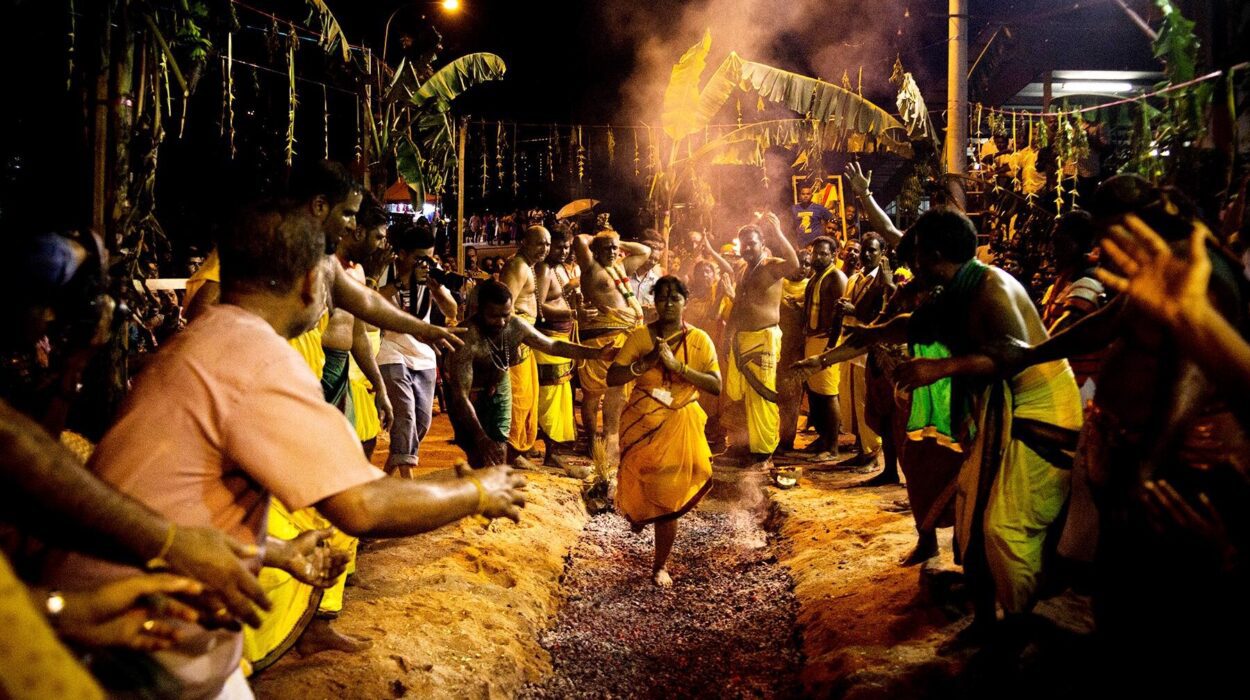In Tamil Nadu, India, the Thimithi festival is a vibrant and colorful celebration with a lot of cultural and religious significance. It is celebrated in honor of the goddess Draupadi, who is adored for her purity, strength, and devotion. It is also known as the “fire-walking festival.” The festival is marked by a series of rituals and practices that have been handed down through the generations. These practices may or may not be the same in every region where it is celebrated. The Thimithi festival is still a significant cultural event that brings communities together and fosters social harmony, despite the challenges it faces today. In this blog post, we will discuss the Thimithi festival’s history, customs, and significance, as well as the difficulties it faces and the efforts being made to preserve and promote this one-of-a-kind and ancient custom.
Origins of the Thimithi festival
The history of the Thimithi festival is fascinating and rich, and it is deeply entwined with Hindu mythology and custom. The ancient epic Mahabharata, which tells the story of the five Pandava brothers and the heroic battles they fought against their Kaurava cousins, is where the festival got its start.
Legend has it that the Pandavas were at a crossroads and on the verge of defeat during the battle of Kurukshetra. They sought protection and assistance from the goddess Draupadi in a desperate moment. Draupadi appeared before them and granted their wishes, moved by their devotion.

The Pandavas promised to honor Draupadi with a series of penances and rituals, including the Thimithi festival, as a way to show their gratitude. It is believed that the festival is a symbol of Draupadi’s resilience and strength in the face of adversity, as well as her capacity to safeguard and assist her devotees.
The Thimithi festival became ingrained in Tamil Nadu’s religious and cultural practices over time. Millions of people across the state celebrate it today, and it is recognized as a significant occasion for fostering community and social harmony.
Celebration of the Thimithi festival
The Thimithi celebration is regularly commended during the Tamil month of Aippasi (October-November), and it goes on for a few days. The region in which the festival is celebrated has a slight impact on the rituals and practices that mark the occasion.
The fire-walking ceremony is one of the most significant traditions associated with the Thimithi festival. This entails crossing a smoldering coal pit, which is thought to represent the difficulties and trials the Pandavas encountered during their battles. It is believed that those who are pure of heart and mind will be protected during the fire-walking ceremony, which is seen as a test of faith and devotion.

Devotees perform a series of penances and purifications prior to the fire-walking ceremony, which may include meditation, abstinence, or fasting. They also take part in elaborate rituals and processions, like carrying Draupadi’s chariot and other gods through the village or town’s streets.
Traditional dance and music, such as Pinnal Kolattam and Karakattam, are also performed during the Thimithi festival in some parts of Tamil Nadu. These forms of folk art are regarded as an essential component of the festival and are believed to have originated from the ancient worship of the goddess Draupadi.
In general, the Thimithi festival celebration is a happy and festive occasion that brings people from all walks of life together. Reaffirming one’s faith and devotion are all part of this time of reflection and renewal.
Thimithi festival in different parts of Tamil Nadu
In Tamil Nadu, the Thimithi festival is celebrated with a great deal of enthusiasm and fervor. However, the way the festival is observed varies by region.
In the town of Thiruvannamalai, the Thimithi celebration is commended on the full moon day of the Tamil month of Aadi (July-August). It is believed that the goddess Draupadi married Lord Arjuna, one of the Pandava brothers, during the celebration known as Aadi Pooram. The celebration includes a terrific parade of the gods around the town, finishing in the fire-strolling service.
The ancient Kapaleeswarar Temple is where the Thimithi festival is held in Chennai. Panguni Peruvizha is the name of this festival, which takes place in the Tamil month of Panguni (March-April). The festival is marked by a series of colorful processions that feature traditional dance and music as well as the deities being carried on chariots and palanquins.

The well-known Thirukkadaiyur Temple hosts the Thimithi festival in the Nagapattinam district. Kadirurukku is the local festival, and it takes place in the Tamil month of Aippasi (October-November). In addition to the fire-walking ceremony, the festival includes a number of purification practices.
The ancient Subramanya Swamy Temple is where the Thimithi festival is held in the town of Tiruchendur. The celebration here is known as Soorasamharam, and it is seen during the Tamil month of Aippasi (October-November). The battle between Lord Muruga, the son of Lord Shiva, and the demon Surapadman, which is believed to have occurred during the epic Mahabharata, is portrayed during the festival.
These are just a few examples of how the celebration of the Thimithi festival varies by region in Tamil Nadu. The festival continues to be a potent symbol of state pride, devotion, and unity in spite of these differences.
Significance of the Thimithi festival
In the Tamil Nadu cultural and religious traditions, the Thimithi festival is very important. It is believed that the festival has numerous significant meanings and symbolisms, making it an essential component of the social and spiritual fabric of the state.
The association of the festival of Thimithi with the goddess Draupadi is one of its primary significances. Draupadi is venerated as a figure of strength, bravery, and perseverance, especially in the face of difficulty. As a result, the festival is seen as a way to honor this powerful goddess and ask for her protection and prosperity blessings.

Additionally significant is the festival’s emphasis on faith and devotion. Particularly, the fire-walking ceremony is regarded as a test of faith and belief in the divine. The ceremony becomes a means of reaffirming one’s faith in the divine because it is believed that those who are pure in heart and mind will be protected from harm.
One more significant meaning of the Thimithi celebration is its job in advancing social agreement and local area soul. People of all ages and backgrounds celebrate the festival with great enthusiasm because it brings people from all walks of life together. As a result, the festival is seen as a means of uniting the community and achieving common goals.
In general, the Thimithi festival is a celebration of Tamil Nadu’s extensive spiritual and cultural traditions. Reaffirming one’s faith and devotion are all part of this time of reflection and renewal. The festival is a beloved and enduring part of the state’s cultural identity due to its deep roots in mythology and tradition.
Challenges and future of the Thimithi festival
In Tamil Nadu, the Thimithi festival has been a significant part of the state’s cultural identity for centuries. However, just like a lot of traditional festivals, it now faces a number of difficulties.
The festival’s commercialization is one of the main obstacles. The Thimithi festival has become increasingly commercialized in recent years, with merchandise sales and tourism promotion taking precedence over religious and cultural aspects. Concerns have arisen regarding the festival’s authenticity, integrity, and capacity to preserve its cultural and spiritual significance.

The fact that younger generations are less likely to participate in the Thimithi festival is yet another obstacle. Young people are less likely to participate in traditional festivals like Thimithi because they are becoming less and less connected to their cultural and religious traditions. Over time, the festival’s significance and popularity may decrease as a result of this trend.
There is still hope for the Thimithi festival’s future in spite of these difficulties. Promoting the festival’s cultural and religious significance and involving younger generations in its celebration are the efforts of numerous individuals and organizations. As a means of preserving cultural heritage and fostering social cohesion, the preservation of traditional festivals like Thimithi is also becoming increasingly recognized.
In conclusion, the Thimithi festival continues to be a beloved and significant component of Tamil Nadu’s cultural identity despite the challenges it faces in the modern era. There is hope that the festival will continue to be celebrated for future generations if efforts are made to address these obstacles and highlight its cultural and religious significance.
Conclusion
Tamil Nadu’s Thimithi festival has been a significant cultural and religious celebration for centuries. The celebration of the festival is marked by numerous rituals and ceremonies, including the fire-walking ceremony, which is regarded as a test of faith and devotion. The festival’s origins are rooted in mythology and tradition.
By bringing people from all walks of life together to celebrate and pay homage to the powerful goddess Draupadi, the Thimithi festival has helped Tamil Nadu foster social harmony and community spirit. However, the festival now faces challenges such as commercialization and a decline in younger generations’ participation.
In spite of these difficulties, efforts are being made to raise awareness of the festival’s cultural and religious significance and to involve younger generations in its celebration. With continued efforts to preserve and celebrate its traditions, the Thimithi festival will continue to be celebrated for generations to come. It is still an essential component of Tamil Nadu’s cultural heritage and identity.
FAQs
What is the Thimithi festival?
In Tamil Nadu, the goddess Draupadi is honored during the Thimithi festival, a significant cultural and religious event. The fire-walking ceremony, which is regarded as a test of faith and devotion, is one of the festival’s many rituals and ceremonies.
When is the Thimithi festival celebrated?
During the Tamil month of Aipasi, which falls between October and November, the Thimithi festival is celebrated.
What is the significance of the Thimithi festival?
The association of the Thimithi festival with the goddess Draupadi, its emphasis on faith and devotion, and its role in fostering social harmony and community spirit make it significant.
Where is the Thimithi festival celebrated?
The Thimithi festival is mostly celebrated in Tamil Nadu, but other communities and regions also participate in the celebration with their own distinctive traditions.
Who can take part in the Thimithi celebration?
All ages and backgrounds are welcome to attend the Thimithi festival. However, only those who have undergone extensive training and preparation can take part in the fire-walking ceremony, which is a test of faith and devotion.
Is the Thimithi festival only celebrated in Tamil Nadu?
The Tamil community celebrates the Thimithi festival not only in Tamil Nadu but also in other parts of India and around the world.







